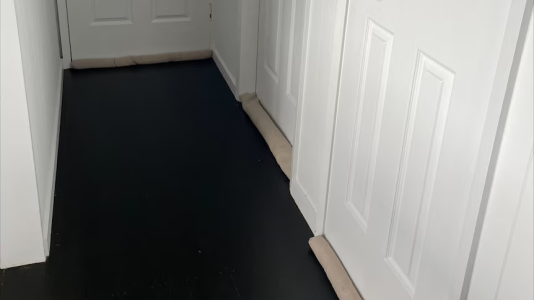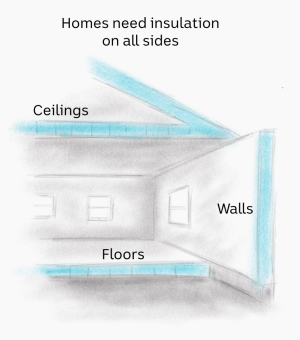What's the most cost-effective way to heat your home this winter? Here are some simple tips
By
ABC News
- Replies 5
As Australia's east coast braces for chilly nights this weekend, that means many of us will be cranking up the heaters and bracing for an eye-watering power bill.
A rise in power prices from July 1 for people in three states also doesn't make things easier.
But there are ways to keep your electricity bill down during winter — while staying warm.
Here are some tips recommended by ABC readers.
You want to avoid the temptation to heat a room any more than you need to, or you'll end up hurting your hip pockets.
Energy Australia recommends setting your temperature between the sweet spot of 18-20C in winter.
Every extra degree increases your heating energy use by up to 10 per cent.
And don't forget to only heat the rooms you are actually using and shut the doors to the others. This concentrates the heat where you need it most.
Here is what experts and some ABC readers suggest, based on their own experiences.
That is because the gap between the two panes of glass acts as a barrier, slowing down the transfer of heat.
It can cost anywhere from $300 to $1,500 per square metre.
If this is out of your budget, there are some other options to consider. This includes thermal film or secondary double glazing that you can attach to existing window fittings.
One ABC reader, Eric, has done exactly this, using perspex and magnetic tape to double glaze the front of his unit, which he says cost him $1,500.
Give them a call to find out what they will offer to keep you as a customer, and then ring up some competitors to compare the prices.
One ABC reader says every time they receive a utilities bill, they upload it to one of the comparison websites to see if there is a cheaper alternative.
"Often I find that there is [a cheaper alternative], and occasionally it's even from the same provider I'm currently with," they said.
"In the past, I've called up my energy or gas provider and asked for a discount, and while this can sometimes be successful, it's often much more hassle than simply connecting to a new company.
"I imagine I have saved hundreds."
Last December, the Australian Competition and Consumer Commission found as many as four in five households could be paying less for electricity by shopping around.
The report showed customers on flat rate market offers that are two or more years old experience average annual prices $317 higher than those on new offers.
One ABC reader who has switched to save on their power bill is Chris O'Neill from Victoria.
Last year, he signed up to OVO's Free 3 plan which gives customers three hours of free electricity every day during the peak solar times between 11am-2pm.
During that period, he switches on four heaters that use 6 kilowatt total, an oven that uses 2kW and the water heater that uses 2.4kW.
That is a total of 10.4kW an hour, or 31.2 kWh per day of free heating.
"I get OVO to charge me $97 per month which is close to what we use but my credit keeps building up when the government puts a credit on my account," Mr O'Neill says.
"My average bill from May to October inclusive in 2023 with Powershop/Nectr energy was $139, so just on electricity alone OVO has saved about $42 per month or $248 in six months."
Other ABC users also spoke about using the three-hour deal.
If you are looking to compare suppliers, this government website can help you find which has the best rate.
If you live in Victoria, visit Victorian Energy Compare.
By Hanan Dervisevic
A rise in power prices from July 1 for people in three states also doesn't make things easier.
But there are ways to keep your electricity bill down during winter — while staying warm.
Here are some tips recommended by ABC readers.
Be smart with your thermostat
No, this doesn't mean setting your air conditioner to 28 degrees Celsius.You want to avoid the temptation to heat a room any more than you need to, or you'll end up hurting your hip pockets.
Energy Australia recommends setting your temperature between the sweet spot of 18-20C in winter.
Every extra degree increases your heating energy use by up to 10 per cent.
And don't forget to only heat the rooms you are actually using and shut the doors to the others. This concentrates the heat where you need it most.
Don't have a heater?
That's okay! There are still some easy, low-cost changes you can implement to keep warm.Here is what experts and some ABC readers suggest, based on their own experiences.
- Layer up
- Blankets
- Thermal cur
- Reverse ceiling fans
- Adjust hot water system temperature
- Draught proof cracks and gaps
- Unplug vampire appliances
- Use your local council's energy efficiency kits
Upgrades on the pricier side
If you are looking for longer-term investments, here are a couple of home upgrades you could do.Insulation
Let's start off with the savings you could make from installing insulation:- Ceiling: 45 per cent or more on heating costs
- Walls: up to 25 per cent
- Floors: 20 per cent
Double-glazed windows
According to the Victorian government, double-glazed windows retain up to 30 per cent more heat and conditioned air than single-glazed windows.That is because the gap between the two panes of glass acts as a barrier, slowing down the transfer of heat.
It can cost anywhere from $300 to $1,500 per square metre.
If this is out of your budget, there are some other options to consider. This includes thermal film or secondary double glazing that you can attach to existing window fittings.
One ABC reader, Eric, has done exactly this, using perspex and magnetic tape to double glaze the front of his unit, which he says cost him $1,500.
Try switching providers
Don't assume your current energy provider is offering you the best deal available.Give them a call to find out what they will offer to keep you as a customer, and then ring up some competitors to compare the prices.
One ABC reader says every time they receive a utilities bill, they upload it to one of the comparison websites to see if there is a cheaper alternative.
"Often I find that there is [a cheaper alternative], and occasionally it's even from the same provider I'm currently with," they said.
"In the past, I've called up my energy or gas provider and asked for a discount, and while this can sometimes be successful, it's often much more hassle than simply connecting to a new company.
"I imagine I have saved hundreds."
The report showed customers on flat rate market offers that are two or more years old experience average annual prices $317 higher than those on new offers.
One ABC reader who has switched to save on their power bill is Chris O'Neill from Victoria.
Last year, he signed up to OVO's Free 3 plan which gives customers three hours of free electricity every day during the peak solar times between 11am-2pm.
During that period, he switches on four heaters that use 6 kilowatt total, an oven that uses 2kW and the water heater that uses 2.4kW.
"I get OVO to charge me $97 per month which is close to what we use but my credit keeps building up when the government puts a credit on my account," Mr O'Neill says.
"My average bill from May to October inclusive in 2023 with Powershop/Nectr energy was $139, so just on electricity alone OVO has saved about $42 per month or $248 in six months."
Other ABC users also spoke about using the three-hour deal.
If you are looking to compare suppliers, this government website can help you find which has the best rate.
If you live in Victoria, visit Victorian Energy Compare.
By Hanan Dervisevic










